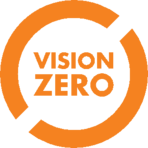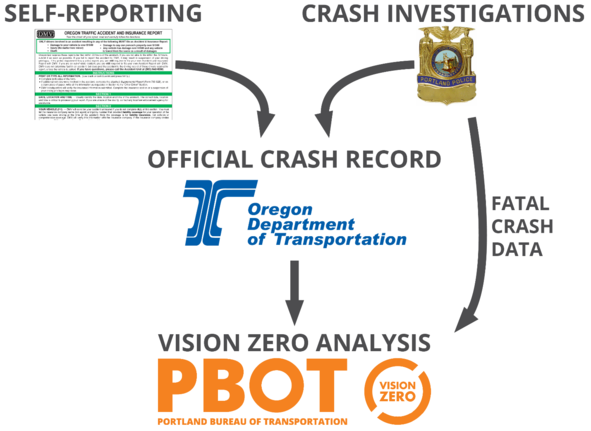 News media contact:
Dylan Rivera
(503) 823-3723
dylan.rivera@portlandoregon.gov
@pbotinfo
News Blog:
Better crash data will sharpen Vision Zero focus
By Matt Ferris-Smith, Portland Bureau of Transportation
 (Nov. 15, 2016) Crash data helps PBOT decide where and how to invest in
safety. But the time between when a crash happens and when the data reach PBOT’s Vision Zero
team for analysis can take months.
Reducing that delay, and gathering better data on the role
of speed, impairment and distraction in crashes, are key pieces of Portland’s draft Vision Zero
Action Plan.
The Action Plan includes three items that
will make crash data faster and more thorough:
-
EA.5 Improve timeliness of deadly and
serious crash data processing and reporting
-
EA.8 Secure increased funding and personnel
to staff timely investigation of deadly crashes
-
EA.9 Improve data collection on speed,
impairment, and distraction at serious and deadly crashes
Other data-related actions call on PBOT to crosscheck crash
data with trauma
data to identify discrepancies, and to review crash and equity data
regularly with Portland Police.
“Vision Zero is data-driven and has a fast timeline, which
means we need to have the best data possible, as quickly as possible, guiding
our investments,” says Clay Veka, PBOT’s Vision Zero Project Manager.
Life of a crash: How data reaches PBOT
Before getting to PBOT, crash data touches as many as four
groups: the public, the DMV, Portland Police and the Oregon Department of
Transportation (see figure).
Most crash data is self-reported through the DMV. People in
Oregon who are involved in a crash must submit
a DMV form if that crash (1) involves a motor vehicle, and (2) results in
an injury or at least $1,500 in property damage.
Portland Police gather data only on the most serious
crashes—those that result in a crash victim traveling in an ambulance, or
when emergency responders enter victims into the trauma system. Compared to
self-reported crashes, police gather and report more detailed information on crashes,
such as alcohol use. (View the DMV
form that police use.)
Both self-reported and police data are sent to ODOT for
analysis and reporting. ODOT makes the official crash record available to PBOT
and the public about 10 months after the end of the year reported; for example,
the agency released crash data for the year 2013 in November 2014.
|

Vision Zero will reduce delay, fill gaps
Under Vision Zero, PBOT will work with the DMV, Portland
Police and ODOT to accelerate the release of data on crashes that result in
deaths or serious injuries.
Vision Zero also needs better data on the role of speed,
impairment and distraction in serious crashes. Records from 2004 to 2013 show
that speed and impairment were factors in 47 percent and 56 percent of
Portland’s deadly crashes, respectively. Conversations with traffic
investigators and safety experts suggest that the actual numbers are probably
higher. Distracted driving is also likely underreported.
Excluded entirely are crashes not involving motor vehicles,
which includes incidents in which people biking crash on rail tracks.
As Vision Zero moves forward, more timely and comprehensive
crash data will help PBOT make smarter, quicker decisions about safety
investments, says Veka, who adds that equity will also play a role.
“Our Task Force made
it clear that they want a process that uses both crash data and
equity
data to guide our Vision Zero investments. We’ll be using both to
prioritize improvements in the areas that need them most.”
###
Portland is committed to ending traffic violence in our
communities. Through the Vision
Zero program, the City of Portland and our partners are working to
eliminate deaths and serious injuries on our streets by 2025.
The Vision Zero Task
Force has overseen the creation of a draft Vision Zero
Action Plan with specific steps to make streets safe. This draft plan
will go to Portland's City Council for approval on Thursday, December
1, at 3 p.m.
The Portland Bureau of Transportation (PBOT) is the steward of the City’s transportation system, and a community partner in shaping a livable city. We plan, build, manage and maintain an effective and safe transportation system that provides access and mobility. Learn more at www.portlandoregon.gov/transportation
|